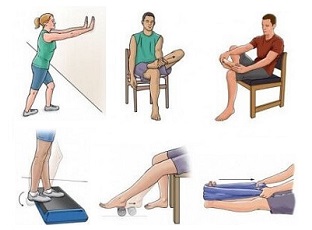- Home
- Diagnosis Guide
- Toe Pain
- Hammer Toe
Hammer Toe
Written By: Chloe Wilson BSc(Hons) Physiotherapy
Reviewed By: FPE Medical Review Board
Hammer toe is a common foot deformity that causes pain and affects daily activities.
One or more of the toes bends forwards and curls over, causing it to resemble a hammer.
Hammer toes are normally caused by wearing tight, narrow footwear which pushes the toes into a cramped position, causing the soft tissues to tighten. This pulls the bones into an abnormal position. The bent toe then starts rubbing on shoes and becomes increasingly painful.
Hammertoe is one of the most common types of toe deformity and is similar but distinctly different from mallet toes and claw toes, where the toe joints bend in different directions.
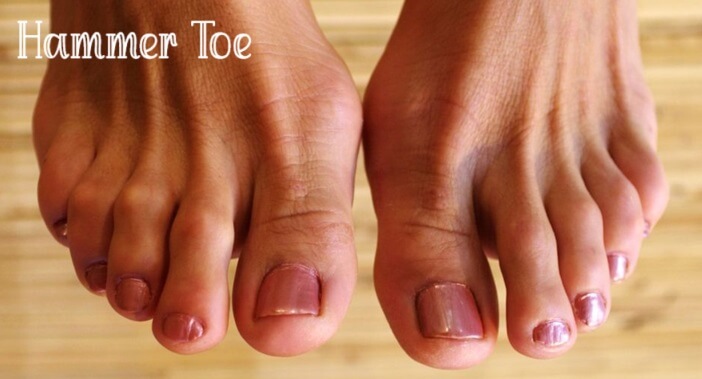
Here we will look at what is hammer toe, the common causes and symptoms, how it is diagnosed, what the best treatment options are and how to prevent hammer toe.
What is Hammer Toe?
Hammer toe is a deformity of the foot where one or more of the smaller toes become abnormally bent, giving the toe a curled or "hammered" appearance. The condition arises when the muscles, tendons, or ligaments that support the toes become imbalanced, leading to abnormal bending.
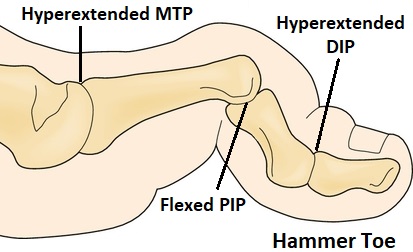
Normally, toes lie flat and can flex or extend smoothly. However, with hammertoe, the proximal interphalangeal (PIP) joint, in the middle of the toe, bends downward.
This causes the joints above (MTP) and below (DIP) to compensate by bending backwards into hyperextension. This combination caused the middle part of the toe to lift up.
Hammer toe can affect any of the smaller toes (not the big toe) but is most common in the second toe. It tends to only occur in one toe at a time, rather than multiple toes.
There are two types of hammer toe:
- Flexible Hammer Toe: The toe can still be moved at the joint, and the deformity can be corrected with manual manipulation. This is the early stage of hammer toe and can often be corrected with non-invasive treatments.
- Rigid Hammer Toe: In more advanced cases, the toe becomes fixed in its abnormal position, making it difficult or impossible to move. Surgical intervention is often necessary to correct rigid hammer toe.
Hammer toe can cause discomfort when walking, especially when wearing shoes that put pressure on the toes. Early diagnosis and treatment are important to prevent progression and avoid complications.
Hammer Toe vs Other Toe Deformities
There are a few other toe deformities that are very similar to Hammer Toe but cause the toes to bend into slightly different positions:
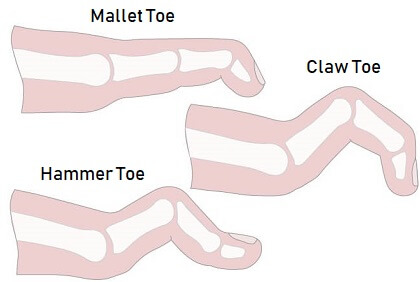
- Mallet Toe: affects the joint closest to the tip of the toe (DIP). This causes the tip of the toe to bend downward, resembling a mallet. It most commonly affects the second toe. Find Out More >
- Claw Toe: both the middle and end toe joints (DIP & PIP) bend forwards, while the joint closest to the foot (MTP) bends backwards. This causes the toes to curl down, resembling a "claw." It often affects multiple toes at the same time and is commonly associated with underlying conditions like neurological disorders or high-arched feet. Find Out More >
- Bunions: affect the big toe. The big toe shifts inwards towards the second toe, forming a large, hard lump on the side of the big toe. Find Out More >
While each of these deformities involve abnormal toe positions, the key difference lies in which joints are affected and how the toes curl.
Common Causes of Hammer Toe
Common hammer toe causes include:
- Poorly Fitting Footwear: Tight, narrow, or high-heeled shoes push toes into cramped positions, tightening and shortening muscles and tendons over time. This is the most common cause of hammer toe
- Muscle Imbalance: Muscles work in pairs. When the muscles pulling the toes down overpower those lifting them up, the toe starts to bends at the middle joint. Imbalances often stem from altered foot mechanics like high arches or flat feet.
- Genetics: Inherited foot structures, such as long toes or a family history of foot issues, can increase hammertoe risk.
- Injury: Toe injuries—like stubbing, fractures, or sprains—may lead to improper healing and muscle imbalance, contributing to hammer toe.
- Medical Conditions: Conditions like rheumatoid arthritis, gout, osteoarthritis, diabetes, and neuropathy can weaken foot muscles, increasing hammertoe risk.
- Age and Gender: Hammer toe becomes more common with age, and women are at higher risk, most likely due to frequent use of high heels or narrow-toed shoes.
Hammer Toe Symptoms
Hammer toe symptoms can range from mild discomfort to significant pain, depending on the severity of the deformity. Common symptoms include:
- Toe Appearance: The most common symptom of hammer toe is the abnormal bend in the middle joint which gives the toe a curled, “hammer” like appearance. Initially flexible, it may become rigid over time.
- Pain and Discomfort: Pain often occurs at the top of the bent toe where it rubs against shoes, ranging from mild to severe, especially when walking or standing for long periods.
- Corns and Calluses: Friction from shoe rubbing can lead to painful corns and calluses (hard, thickened areas of skin) on the bent toe which may require separate treatment. Find Out More >
- Stiffness: As the condition progresses, the toe may stiffen, limiting movement and affecting foot function.
- Swelling and Redness: Chronic rubbing can inflame the toe, causing redness, swelling, and blisters.
- Difficulty Walking: Hammer toe can alter gait and function, leading to pain in other parts of the body like the ankles, knees, or back. It can also affect your balance.
Hammer Toe Diagnosis
Diagnosing hammer toe is relatively straightforward and usually involves an examination by a podiatrist or orthopedic specialist. During the exam, the doctor will visually inspect the affected toes, noting their position and the degree of deformity. They will look for any associated symptoms, such as corns, calluses, or inflammation.
They will also assess whether the toe is still flexible or if it has become rigid by moving the toes in different directions. In some cases, the doctor will observe how you walk to assess how the hammer toe is affecting your overall foot function and weight distribution.
X-rays may be taken to evaluate the bones and joints of the toes. This is particularly helpful in determining the severity of the deformity and to rule out other potential causes, such as fractures or arthritis.
If an underlying condition like diabetes or rheumatoid arthritis is suspected, additional neurological and muscular tests may be performed to assess the health of your nerves, muscles, or joints.
#CommissionEarned from Amazon on qualifying purchases
How To Fix Hammer Toe
Hammer toe treatment aims to reduce pain, correct the toe position and improve foot function, and may involve:
1. Changing Footwear
The first and often most effective hammer toe treatment is switching to shoes that have a wide toe box, providing plenty of space for the toes to move freely.
Shoes should be wide, cushioned and comfortable, avoiding high heels or tight-fitting styles that put pressure on the toes. Shoes with soft, flexible materials and low or flat heels are ideal for reducing pain and preventing further progression.
2. Orthotics
Orthotic shoe inserts can be really helpful for correcting foot mechanics and reducing pressure on the hammertoe. There are a variety of styles available, the most popular being:
- Hammer Toe Splints: wrap around the affected toe and the neighbouring toe to help stabilize, align and straighten the affected toe. Find Out More>
- Hammer Toe Straighteners: flexible and elastic silicon loop that fits around the affected toe with a small wedge underneath to help correct toe position. Find Out More >
- Toe Sleeves: soft, protective sleeves that fit around individual toes to straighten them and reduce friction. May be made of silicon or fabric. Find Out More >
- Gel Loop Crests: Soft, flexible gel that loops around the toes with a cushioning bar underneath to help realign the toes and reduce pressure through them. Find Out More >
- Hammer Toe Pads: Cushions that support the toe and reduce pressure through the tips to make walking more comfortable. Find Out More >

3. Hammer Toe Exercises
For flexible hammertoe, exercises that strengthen and stretch the muscles and tendons in the toes and feet can help correct the deformity.
Common hammer toe exercises include:
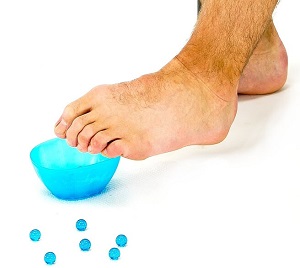
- Toe Stretching: Use your hands to gently pull the affected toe into a straight position and hold for several seconds.
- Towel Curls: Place a towel on the floor and use your toes to scrunch it up, strengthening the muscles in the foot and toes.
- Marble Pickups: Try picking up small objects, like marbles, with your toes to enhance dexterity and muscle strength.
You can find loads more foot stretches and strengthening exercises in the foot exercise section.
4. Corn and Callus Care
To alleviate discomfort caused by corns or calluses, your doctor may trim them or recommend using padded corn cushions or moleskin to reduce pressure and friction. Find Out More >
Hammer toe treatment is most effective in the early stages while the toe is still flexible.
Hammer Toe Surgery
If there is ongoing pain and rigid deformity despite conservative treatments, then your doctor may recommend surgery to correct the hammer toe. This may involve:
- Tendon Release: lengthening the tight tendons that are pulling on the joints so the toe can straighten out fully and return to its natural position
- Tendon Transfer: tendons from the bottom of the foot are moved to the top of the foot to help pull the joint straight
- Digital Arthroplasty: part of the toe joint is removed so that the toe can lie flat. Allows for some movement in the toe post-surgery
- Digital Arthrodesis: aka toe fusion. The deformed joint is removed completely and he bones are held in place with wires, pins or plates until they fuse together. The joint will be permanently straight, it will not be able to bend at all.
Following hammer toe surgery, you will be given a special shoe or boot to wear to protect the foot and may need to use crutches for a while. It usually takes 2-4 weeks to be able to wear normal shoes and return to work (depending on your profession).
It will take around 4-8 weeks to return to driving and sports, sometimes longer. You will be given a range of strengthening and stretching exercises by a physical therapist to ensure you regain full strength, flexibility and function in the foot.
How To Prevent Hammer Toe
There are several steps you can take to reduce the risk of developing hammer toe or to prevent the condition from worsening:
- Wear Proper Footwear: Choose shoes that have a wide toe box, plenty of cushioning, and a low heel. Avoid shoes that are too tight or that force your toes into cramped or bent positions.
- Strengthen Your Feet: Regular foot and toe exercises can help keep the muscles strong and balanced. Exercises such as toe stretches, towel curls, and picking up objects with your toes can help maintain muscle flexibility and strength.
- Avoid High Heels: Limit the use of high-heeled shoes, as they shift body weight onto the toes and can contribute to the development of hammer toe.
- Seek Early Treatment: If you notice any changes in your toes, such as a slight bend or stiffness, seek early treatment to prevent the deformity from worsening.
By adopting these measures, you can significantly reduce your risk of developing hammertoe and maintain overall foot health.
Hammer Toe Summary
Hammer toe is a common foot deformity where one or more smaller toes bend abnormally at the middle joint, creating a curled or "hammered" appearance. It can develop due to factors like ill-fitting footwear, muscle imbalances, trauma, or underlying medical conditions.
Common hammer toe symptoms include visible toe deformity, pain, corns/calluses, and difficulty walking. Early diagnosis through a physical exam can identify whether the hammertoe is flexible or rigid, which determines the appropriate treatment.
Non-surgical treatment options like footwear modifications, orthotics, and toe exercises can often relieve symptoms and prevent progression in mild cases. In more severe or rigid hammer toe, surgical procedures like tendon release or joint fusion may be required to straighten the toe.
There are other types of toe deformity, similar to hammer toe – mallet toe, claw toe and bunions.
You may also be interested in the following articles:
Related Articles
Page Last Updated: 7th November, 2024
Next Review Due: 7th November, 2026
